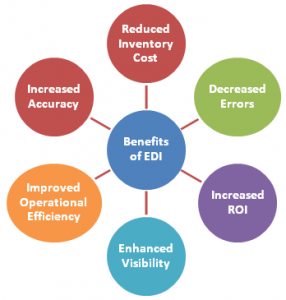Purpose of EDI:-
- The purpose of EDI is to enable the exchange of the information for commercial transactions among information systems in different companies accurately, efficiently and economically. A number of standards for communication protocols and data formats have been developed for EDI in ISO (International Standardization Organization) and ANSI (American National Standard Institute).
- EDI techniques are aimed at improving the interchange of information between trading partners, supplies and customers by bringing down the boundaries that restrict how they interact and do business with each other.
- To facilitate the easy exchange of business documents such as purchase orders, invoices, payments, shipping schedules, delivery schedules etc. irrespective of the computer s application at either end of the communication.
- To enable the computer in one organization to communicate with a computer in another organization without producing any paper documents or human intervention.
Computer-to-computer exchange of business information has become an increasingly popular because the firms could exchange business information much faster than earlier at least expense and more accuracy as compared to the paper based systems.
Pre-conditions for EDI implementation:-

In order to switch over to EDI, a company must have computerized accounting records and establish trading partners who agree to exchange EDI transactions.
EDI configuration will involve transaction software at all participating sites, with a standard communications package to transfer the converted documents between locations.
In order to achieve the benefits of EDI at maximum, it is required that EDI system should handle the same EDI format both inside and outside a company However, regional and industrial standard is premature at present. Thus, the EDI system has to handle multiple formats.
EDI is used in various organizational functions and in industries like manufacturing, shipping, warehousing utilities, pharmaceuticals, construction, petroleum, banking, insurance, retailing, government etc.
EDI consists of standardized electronic-message formats for business documents such as requests for quotations, purchase orders, receiving invoices etc.
Cost of EDI:-
The cost of EDI could be for the following:-
- Implementation costs:-
Purchase of hardware, software, telephone lines, communication equipment training and management time.
- Running costs:-
Rental of telephone lines, call or packet charges, other communication costs, equipment maintenance, help desks, continuous staff training.
- Study and decision making:-
Researching the market, deciding to use or not to use EDI. Selection of a system appropriate to the needs of an organization.
- Other reorganization costs:-
From new forms and stationery to office moves and redundancy payments
The key features of EDI are:-
- The use of an electronic transmission medium.
- The use of structured, formatted messages based upon agreed standards.
- The fast delivery of electronic documents from sender to receiver.
- The direct communication between applications and systems.
The key benefits associated with EDI include:-

- Easy extension of business activities from a local market to a global one.
- Lower costs in posting and preparation of transactions.
- Increased efficiency in transaction processing.
- Elimination of language barriers in business.
- Lower costs in administration and processing
- Higher competitiveness of firms using EDI
- Elimination paper-handling tasks.
- Quick exchange of document.
- Reduction of payment barriers.
- Increased customer service.
- Shortening transaction time.
- Lower inventory costs.
- Unlimited time of work.
- Elimination of errors.